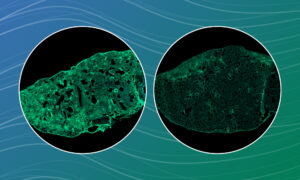Read the latest Issue
Designing gene therapy
Information on structure of molecule used for genome engineering yields increased efficiency

Scientists at EMBL have increased the efficiency of a genome-engineering tool called Sleeping Beauty, which is showing promise in clinical trials for leukaemia and lymphoma immunotherapies. In a study published today in Nature Communications, they reveal structural information that is likely to lead to further enhancements, ultimately resulting in better patient outcomes.
“Based on the structure, we designed new variants that are already 30% more efficient than the most efficient ones currently available,” says Orsolya Barabas, who led the work at EMBL. “That may not sound like a lot, but for patients with only a few months’ prognosis, waiting 3 weeks for a treatment is better than waiting a whole month.”
Sleeping Beauty is a transposon, or ‘jumping gene’, currently being used in clinical trials for B-cell leukaemias and lymphomas. In these treatments, Sleeping Beauty is used to insert a gene into T-cells – white blood cells that help to track down and eliminate threats such as disease-causing microbes – harvested from a patient. The genetically modified T-cells are injected back into the patient, where their new gene enables them to seek out and destroy the cancer cells. The technique is cheaper and easier to apply than current approaches, which mainly rely on modified viruses as deliverymen, so it is rapidly moving into clinical practice, and attracting investment from the pharmaceutical industry.
for patients with only a few months’ prognosis, waiting 3 weeks for a treatment is better than waiting a whole month.
A bottleneck of this method is that it takes time to engineer and select the therapeutic T-cells. The quicker the T-cells can be modified and transplanted back, the better the treatment prognosis for the patients, and the lower the costs. Until now, however, efforts to increase the treatment’s efficiency were educated guesses, based on the structure of similar molecules. Franka Voigt, a postdoc in Barabas’ lab, determined the 3-dimensional structure of Sleeping Beauty’s active domain. Working with Zoltán Ivics’ lab at the Paul Ehrlich Institute in Germany, the EMBL scientists then used that information to design changes to that structure to make it work better.
More efficient than CRISPR
Transposons like Sleeping Beauty have advantages for therapies that hinge on inserting a gene, compared to other genome engineering approaches such as CRISPR/Cas9. Researchers can make CRISPR/Cas9 cut the genome at a specific point – making it ideal for eliminating genetic errors – but it doesn’t insert any genetic material; the gene is added separately, and is only one of several options available to the cell’s machinery to repair the cut. By contrast, Sleeping Beauty inserts the extra genetic material directly into the genome – and the EMBL scientists’ enhancements now make it even more efficient.
“Ideally, you’d want to combine the targeting of CRISPR and the efficiency of Sleeping Beauty – but that’s proving very, very difficult,” says Barabas, “so it makes sense to pursue the applications that each is best at, at least for the time being.”
it makes sense to pursue the applications that each is best at
Sleeping Beauty inserts the extra genetic material at random, so there is a risk – albeit a small one – that the addition could disrupt the cell’s genome. To minimise this risk, the therapies currently being trialled involve carefully selecting which T-cells to inject back into a patient, which takes time.
The scientists are continuing to design mutations to try to increase Sleeping Beauty’s efficiency even further. In parallel, Barabas’ lab strives to uncover the structure of the whole molecule bound to the DNA that it acts upon, as this could provide insights for further improvements. Such future improvements could make Sleeping Beauty-based therapies feasible for other conditions such as solid tumours, where the current versions of Sleeping Beauty are not efficient enough.







